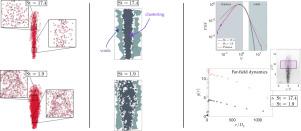当前位置:
X-MOL 学术
›
Int. J. Multiphase Flow
›
论文详情
Our official English website, www.x-mol.net, welcomes your feedback! (Note: you will need to create a separate account there.)
Inertial particle clustering due to turbulence in an air jet
International Journal of Multiphase Flow ( IF 3.8 ) Pub Date : 2024-01-24 , DOI: 10.1016/j.ijmultiphaseflow.2024.104734 Bianca Viggiano , Kris Gish , Stephen Solovitz , Raúl Bayoán Cal
International Journal of Multiphase Flow ( IF 3.8 ) Pub Date : 2024-01-24 , DOI: 10.1016/j.ijmultiphaseflow.2024.104734 Bianca Viggiano , Kris Gish , Stephen Solovitz , Raúl Bayoán Cal

|
Explosive volcanic eruptions create turbulent plumes of fine ash particles. When these particles collide in the presence of moisture and electrostatic fields they combine into larger aggregates, which can significantly change the atmospheric residence time of the airborne cloud. Previous studies have suggested that turbulence may lead to preferential concentration—also known as clustering—of particles within the flow, increasing the likelihood of collisions and aggregation. Few experimental studies have quantified these processes for volcanic plumes. This behavior was investigated using a particle-laden air jet. By systematically varying the exit speed and the size, density, and concentration of particles, flows were produced with Reynolds numbers of 4940 to 19300, Stokes numbers of 1.0 to 17.4 (based on the convective scale), and particle mass loadings of 0.3 to 3.9%. Specific emphasis is placed on two Stokes numbers of 1.9 and 17.4, which differ by nearly an order of magnitude. Particle image velocimetry was employed to measure the velocity distribution within a two-dimensional rectangular region along the jet centerline in each experiment. Voronoï decomposition was used to quantify the extent of preferential concentration by measuring the distribution of cell sizes around each individual particle. Results show that particles exhibit clustering behavior when Stokes numbers are close to 1. We also measured the radial distribution functions (RDFs) to quantify the likelihood of particle collisions. At low Stokes number, the RDF magnitude was significantly higher, which corresponds to increased collision frequency in the particle-laden jet. Computational analysis finds that increasing the RDF by a factor of 20 results in a doubling of peak aggregate size. These findings demonstrate that preferential concentration due to turbulent structures could have important effects on collision frequencies, ash aggregation, and electrification in volcanic plumes.
中文翻译:

由于空气射流中的湍流而产生的惯性粒子聚集
火山爆发会产生细小火山灰颗粒的湍流羽流。当这些颗粒在湿气和静电场的存在下碰撞时,它们会结合成更大的聚集体,这可以显着改变空气云的大气停留时间。先前的研究表明,湍流可能会导致流内颗粒的优先集中(也称为聚集),从而增加碰撞和聚集的可能性。很少有实验研究量化火山羽流的这些过程。使用载有颗粒的空气射流研究了这种行为。通过系统地改变出口速度以及颗粒的尺寸、密度和浓度,产生雷诺数为 4940 至 19300、斯托克斯数为 1.0 至 17.4(基于对流规模)和颗粒质量负载为 0.3 至 3.9 的流%。特别强调两个斯托克斯数 1.9 和 17.4,它们相差近一个数量级。在每个实验中,采用粒子图像测速技术来测量沿射流中心线的二维矩形区域内的速度分布。 Voronoï 分解用于通过测量每个单独颗粒周围的细胞尺寸分布来量化优先浓度的程度。结果表明,当斯托克斯数接近 1 时,粒子表现出聚集行为。我们还测量了径向分布函数 (RDF) 以量化粒子碰撞的可能性。在低斯托克斯数下,RDF 幅度显着更高,这对应于充满颗粒的射流中碰撞频率的增加。计算分析发现,将 RDF 增加 20 倍会导致峰值聚集体尺寸加倍。这些发现表明,湍流结构导致的优先浓缩可能对火山羽流中的碰撞频率、火山灰聚集和带电产生重要影响。
更新日期:2024-01-24
中文翻译:

由于空气射流中的湍流而产生的惯性粒子聚集
火山爆发会产生细小火山灰颗粒的湍流羽流。当这些颗粒在湿气和静电场的存在下碰撞时,它们会结合成更大的聚集体,这可以显着改变空气云的大气停留时间。先前的研究表明,湍流可能会导致流内颗粒的优先集中(也称为聚集),从而增加碰撞和聚集的可能性。很少有实验研究量化火山羽流的这些过程。使用载有颗粒的空气射流研究了这种行为。通过系统地改变出口速度以及颗粒的尺寸、密度和浓度,产生雷诺数为 4940 至 19300、斯托克斯数为 1.0 至 17.4(基于对流规模)和颗粒质量负载为 0.3 至 3.9 的流%。特别强调两个斯托克斯数 1.9 和 17.4,它们相差近一个数量级。在每个实验中,采用粒子图像测速技术来测量沿射流中心线的二维矩形区域内的速度分布。 Voronoï 分解用于通过测量每个单独颗粒周围的细胞尺寸分布来量化优先浓度的程度。结果表明,当斯托克斯数接近 1 时,粒子表现出聚集行为。我们还测量了径向分布函数 (RDF) 以量化粒子碰撞的可能性。在低斯托克斯数下,RDF 幅度显着更高,这对应于充满颗粒的射流中碰撞频率的增加。计算分析发现,将 RDF 增加 20 倍会导致峰值聚集体尺寸加倍。这些发现表明,湍流结构导致的优先浓缩可能对火山羽流中的碰撞频率、火山灰聚集和带电产生重要影响。



























 京公网安备 11010802027423号
京公网安备 11010802027423号